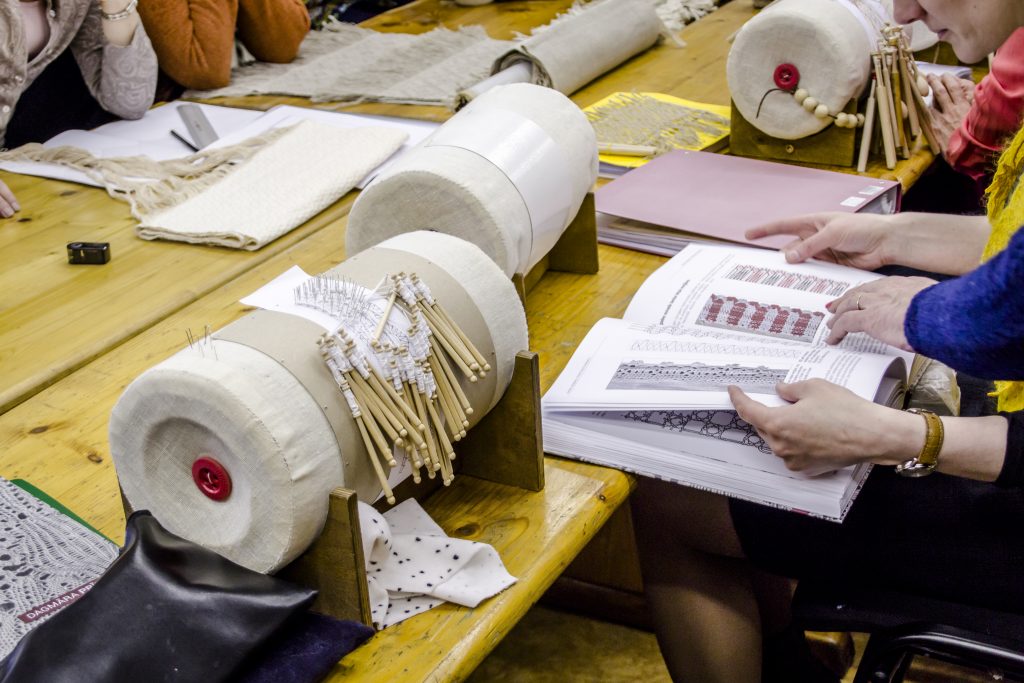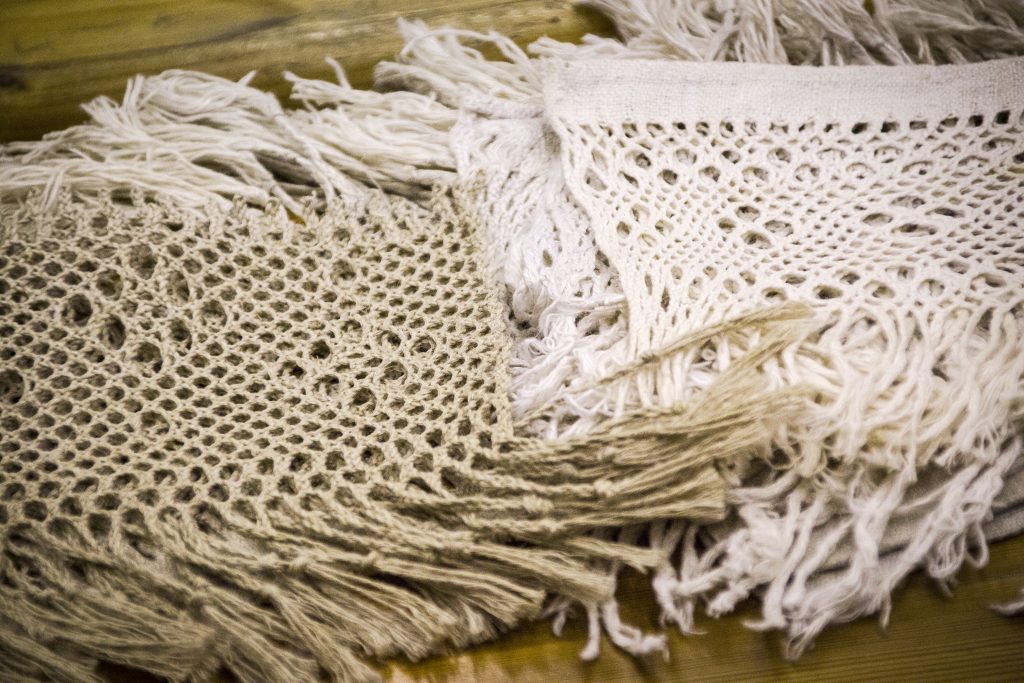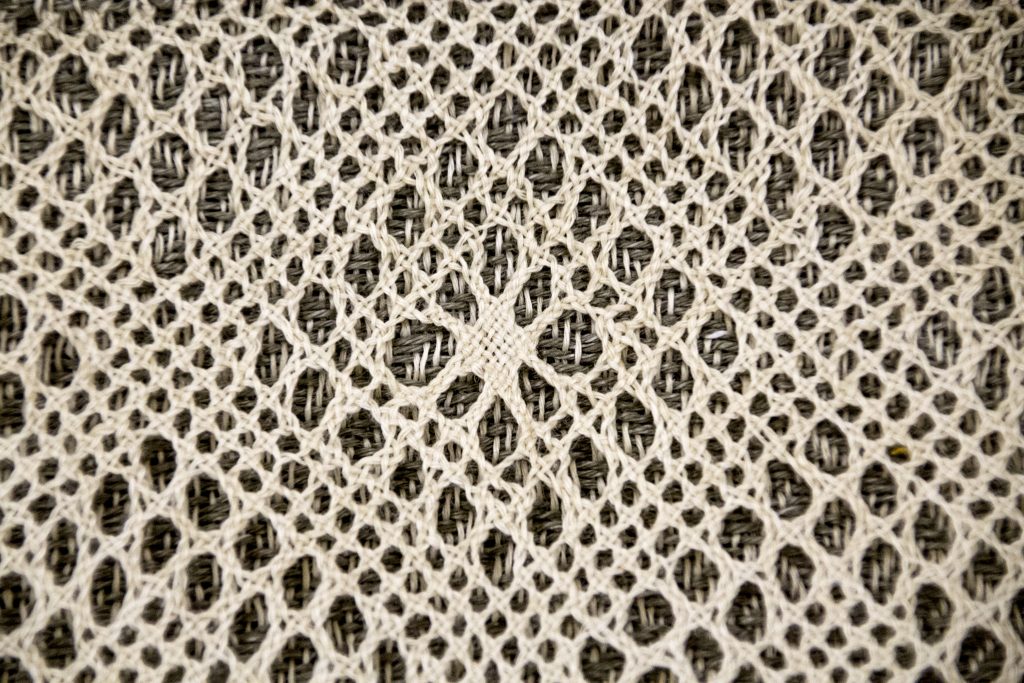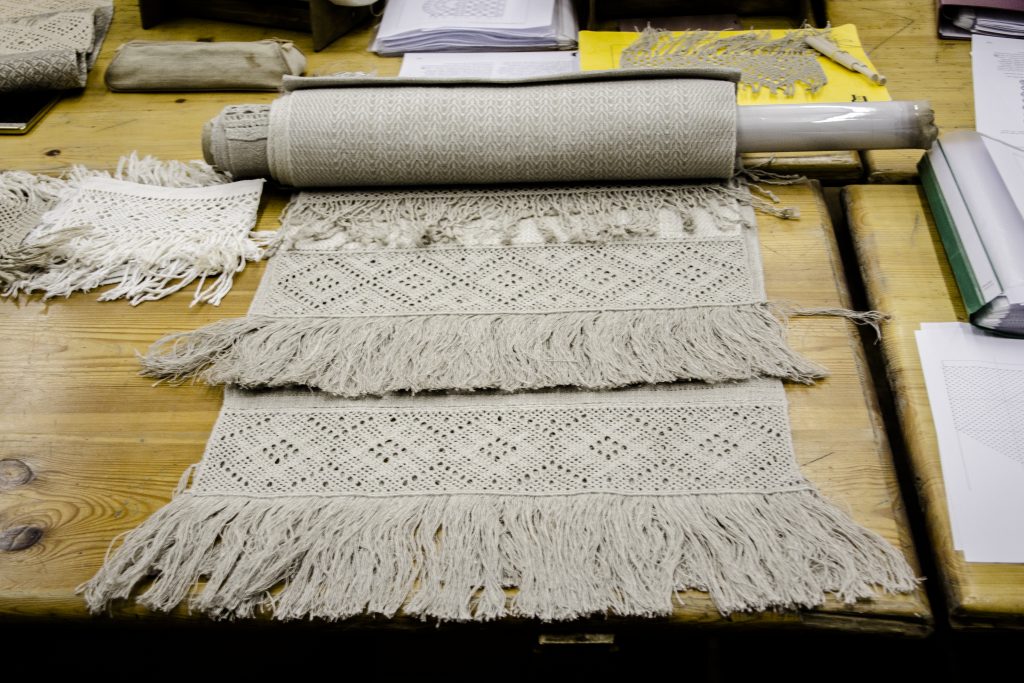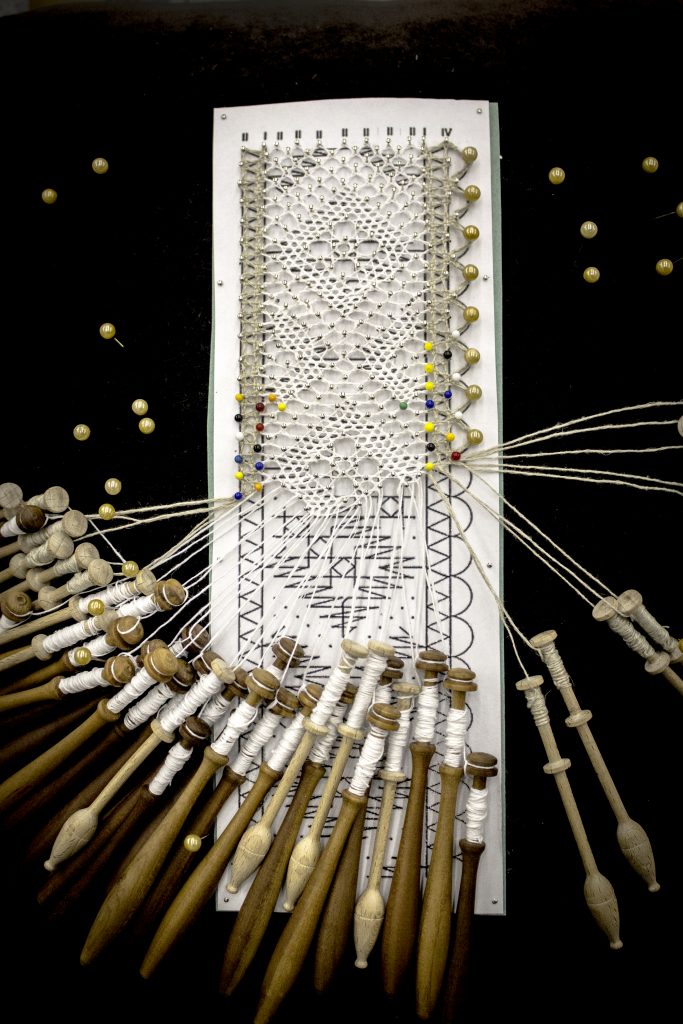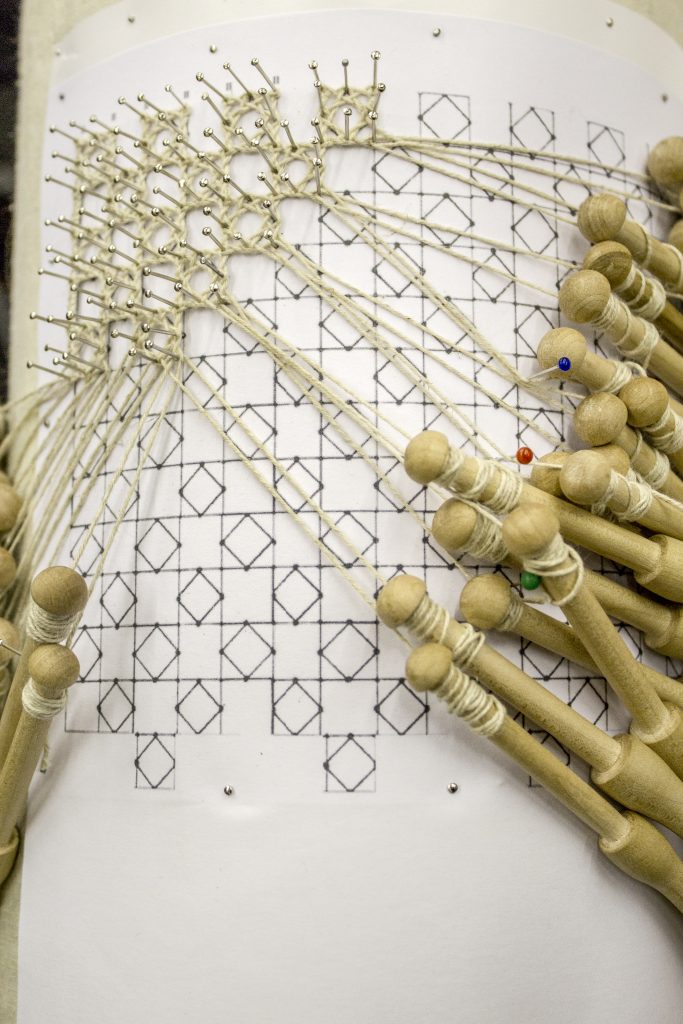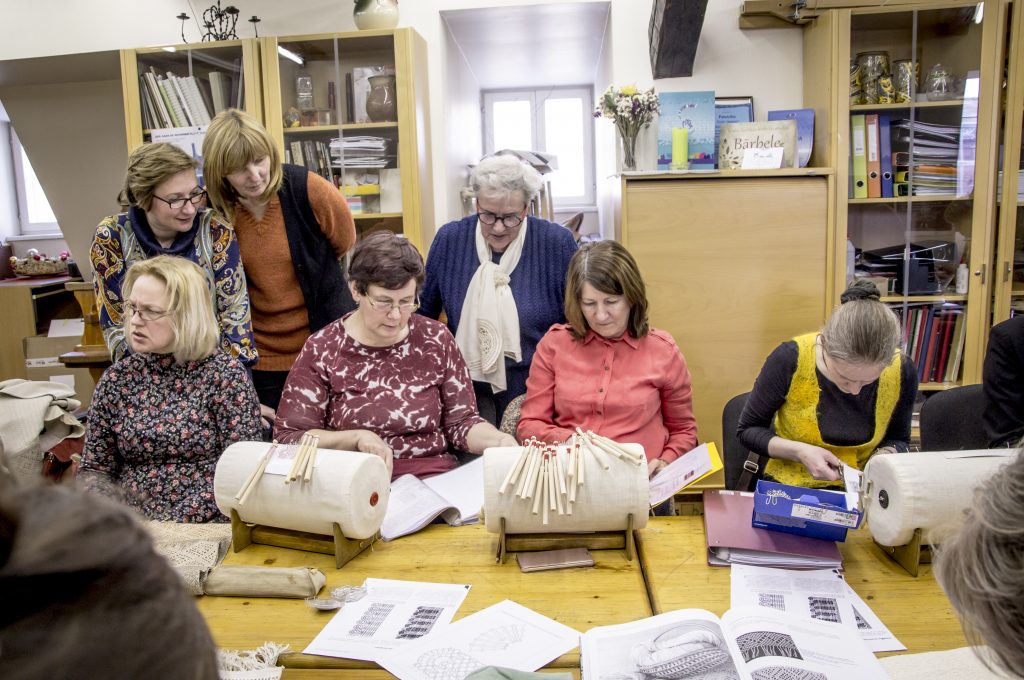Author:
Dagmāra Prīberga
Traditional craft skills
Title
The Skill of Bobbin Lace Making (2018)
The association “Latvian People's Art Union”, the cultural and human art centre “Ritums” of the municipality of Riga, the Latvian lace maker association “Savija”, TLMS “Saulīte”, TLMS “Bārbele”, TLMS “Rota”.
Importance in Community Life
Activities
Bobbin lacemaking is one of the techniques of making lace. Such lace is used to adorn towels, handkerchiefs, scarves, miscellaneous clothing details. The crafter works with several dozens and even hundreds of pairs of bobbins; a needle or a crocheting needle is an auxiliary tool.
Bobbins are approximately 15 cm long wooden cones that have a spool on one end for holding the thread. By crossing and swapping the bobbins, the threads that they hold are also crossed and spun together.
The thread twisting and crossing creates stitches and, through sorting the stitches in different variations, the lace is created. Pins are placed in the intersection points of threads, which helps to create a tight and precise form of lace.
During the bobbin lacemaking process, a drawing is pinned to the base - a special bobbin lacemaking cushion or table - and then removed with the finished product. (D. Prīberga “Senās mežģīnes Latvijā”, page 107)
“In Latvia, the bobbin lacemaking technology allows creating compositions with intricate plant motifs, distinct ribbon patterns or laconic geometric ornaments.” (D. Prīberga “Mežģīņu mantojums Latvijā”, page 289)
Inheritance and Transfer
One person who can be considered a true master of the bobbin lacemaking craft is the creative director of the Folk Applied Arts Studio "Bārbele" Dagmāra Prīberga, who has studied the lace heritage in Latvia, paying special attention to the skill of bobbin lacemaking.
D. Prīberga has been leading the FAAS "Bārbele" for more than 30 years.
Maintaining the bobbin lacemaking skills and ensuring the inheritance process is one of the core tasks of the FAAS "Bārbale". Each week, the classes held by the studio gather 10 members of the studio who have been practicing the craft of bobbin lacemaking for more than 30 years.
History
The most ancient samples of bobbin lace in Latvia have been preserved in the burial sites from the Duchy of Kurzeme and in the tombs of Catholic churches, these samples have been dated to be from the 17th and 18th century.
Museum specialists have cleaned and preserved the lace and these lace samples are in good condition. There are no records in the sources of artisans making bobbin lace in Latvia in the 17th and 18th century, it seems that the Dukes had imported the lace from abroad.
The place of manufacture has not yet been determined.
In Latvia, the 18th and 19th centuries can be considered the bloom of bobbin lacemaking, similarly to other forms of textile works. In the 18th century, following the European fashions, clothing adorned with bobbin lace was mainly worn by the wealthy upper class. The Western European School of lacemaking dominated the clothing of the baronesses.
Interestingly, not just fine and luxurious lace was made with bobbins, but also coarse stitches, ribbons and twine, baskets, bags, horse gear and other items used around the household. The bobbin-made elements also appeared in metalworks, leather and other articles.
The creation and development of Latvian local lace traditions is evidenced by ethnographic textiles.
The most ornate lace from the bobbin lace object selection is found in: Latgale – in the traditional folk wear headcloths, shirts and aprons, in Vidzeme and Zemgale – women's hats, in Kurzeme – in headscarves, cloaks and towel ends, used for adornment of skirts, sheets and other household textiles.
Almost all of the of the examples of folk costume lace and linen towel-end lace made in the 20th and 21st centuries are replicas or variations of 19th century ethnographic lace.
This shows that the preservation and development of local lace craft is facilitated by the living traditions of the people – song festivals, weddings, funerals, baptisms and other events.
Masters
Currently, the excellent masters of the craft that are working in the Folk Applied Arts Studio "Bārbele" are:
1. Folk applied arts master Lienīte Dimitre (b. 1940),
2. Folk applied arts master Laima Garā (b. 1956),
3. Folk applied arts master Vanda Podiņa (b. 1964),
4. Māra Rožuleja (b. 1977),
5. Gita Prīberga (b. 1979).
After the bobbin lacemaking courses organised by D. Prīberga, this skill continues to be practised by the FAAS “Rota”, head Aija Krūmiņa (b. 1953).
Members of the studio:
1. Skarleta Mežale (b. 1973),
2. Iveta Cielava-Volkovska (b. 1977),
3. Indra Liedskalniņa (b. 1966),
4. Sandra Platniece (b. 1985),
5. Elīna Liepa (b. 1981).
Valka FAAS "Saulīte" bobbin lacemaking master Inese Pētersone (b. 1957).
Agencies and Institutions
1. Riga City Municipal Culture and Folk Applied Arts Center "Ritums",
2. Latvian Lace Maker Association “Savija”,
3. “Latvian People's Art Union”,
4. TLEM “Saulīte”,
5. TLEM “Rota”,
6. TLEM “Bārbele”.
Strengthening
1) KTMC “Ritums” in co-operation with the Riga education informative methodological centre for Riga residents has organized the basics of the billing technique. (2018, 2019)
2) Dagmāra Prīberga, Chairman of the Board of the Latvian People's Art Union, has developed cultural heritage Textile-work skills and technologies for the adult non-formal lifelong learning programme – textile work courses for “Ancient lace workshop” and courses organised by the educational administration of Jurmala State Administration in Aspazija's house, a branch of the Jurmala Museum (2022).
3) the association “Latvian People's Art Union” organized bobbin lace making workshops – in Smiltene Mayor Manor (2018) and Tukums (2019), in Liepāja exhibition “lace charms and secrets” during the course of the event (2019).
4) the association “Latvian People's Art Union” in co-operation with the National Cultural Centre of Latvia organized a bobbin lace seminar in Tukums (2022) TLMS “Bārbele” at the time of the exhibition “The White Handicraft Path”.
5) the association “Latvian People's Art Union”, in co-operation with the National Cultural Centre of Latvia, organized the bobbin lace making masterclass in Vērmane Garden Festvial Baltica 2022.
6) the association “Latvian People's Art Union”, with the support of the State Cultural Capital Fund, shared an example of good practice regarding the inclusion of the bobbin lace making element in Intangible Cultural Heritage Inventory at the meeting of the General Assembly of the International European Crafts Organisation in Budapest, Hungary (2022)
7) The Latvian Lace Makers' Association “Savija” organizes annual fanned lace exhibitions (2018-2022) and THE CKF has supported the idea of creating a handover skills and traditions of traditions (2021.)
8) The Applied Folk Art studios “Bārbele”, “Saulīte” and “Rota” are organizing bobbin lace making skills training, as well as publications in the journal “Practical Handicraft”.
Impact of these activities: 1) expanding knowledge to stakeholders. The result is shown in exhibition expositions. 2) For ensuring the succession of input performed with measures and masterclasses (for example, training) - residents have been given the opportunity to learn knickering skills. 3) Bobbin lace has returned to folk costume ornaments and details that were almost gone in the 20.gs.90.s. They were replaced by embroidery and crochets.
Support has been received from the promotion and presentation of the National Cultural Capital element in Europe (contract 2022-R-RK002; 709 €) – participation in the meeting of the General Assembly of the European crafts organisation in Budapest 2022 – presentation of the good practice example – the list of intangible cultural heritage and the scripting skills in Latvia).
Support has been received from the Ministry of Education of the State of Jurmala for the organisation of lifelong learning courses (120 hours) (paid for the lecturer and provided premises at the Jurmala Museum branch in Aspasian house).
Support has been received from the Latvian National Cultural Centre for organising seminars and masters (paid for masters).
Support has been received from the establishment of the national Cultural Capital Fund database and the promotion of the element (contract 2022-1-STP-M26050; 1300 €).
Continuity/Development
To ensure the promotion of element visibility (documentation and research):
1) the association “Latvian People's Art Union”, with the support of the State Cultural Capital Fund, will create an accessible computerised database on the website www.krustokrustovij.lv, which contains basic information regarding the specificity of the element - filtering skills, taking into account the specificities of the traditional skills of the municipality. 2023
2) project “Study on Inquisition Officers in Latvia”. The development and www.krustokrustovij.lv of the database system, within which it is planned to carry out the study and its documentation. Complementing data and facts will provide new and accessible information on the options for the preservation and development of the element. A systematised section of the study will be created regarding the clerical skills of candidates – masters in Latvia. An expanded database, such as drawings that are first drawn by hand and scanned on a computer, are improved by using graphic design programs and used to promote the elements of the element's business. This process will identify existing skills scientists that could be involved in the process of setting up a training programme throughout Latvia. The database will provide a basis for the future creation of an interactive learning aid, the main objective of which is to create an idea of the element (traditional skills), which in turn provides support for encouraging, styling and building research and promoting design thinking. 2023-2028
3) it is planned to create an audiovisual material - a masterclass, which is to be placed on the website by the involvement of the interrogators. It is planned to supplement the database with high-quality, high-resolution photos and technical drawings so that they can be used for research, copy and accurate representations (2024-2028).
4) the association “Latvian People's Art Union” in co-operation with the Hungarian intangible cultural heritage house plans to develop a European Structural Fund project on the promotion of element skills among designers/artisans/artists (project submitted in 2023, implementation time in case of project approval from 2023-2025)
In order to increase interest in billing, masters, courses and informative seminars will be organised, as well as an updated database of the Internet platform on lace in Latvia:
1) the association “Latvian People's Art Union” in cooperation with the educational administration of the State of Jurmala is planning to continue to continue the adult informal lifelong learning programme for the residents of Jurmala (the planned activity depends on the attraction of financial support 2023-2028);
2) the association “Latvian People's Art Union” in co-operation with the Tukums Museum and the Tukums fabric workshop plans to organize the billing training courses for teachers in Tukums 2023-2024 (the planned activity depends on the attraction of financial support);
3) planned annual TLEM in the framework of “barbele” exhibitions to promote the use of billed lace lace in towel products, to form informative seminars and masters (2023-2028);
4) to provide an annual supplement to the database on lace in Latvia in the Internet platform with a view to identifying the stock of existing lace and continuing their collection and preservation (2023-2028).
The aim is to strengthen the survival of this intangible cultural element and to raise awareness of the element. Eliminate potential risks affecting the transferability and inheritance of the skills of scripting positions. Improve knowledge and skills through the study of element research and the use of research-based information in the preparation of educational materials.
Threats
Potential hazards.
1. Children and young people do not have a common training system on traditional folk applied arts, disappearing or threatened traditional crafts, including bobbin lacemaking.
2. There are few who know the skills, the masters are ageing.
Applicant
Riga City Municipal Culture and Folk Applied Arts Centre "Ritums", reg. No. 90011524360
Image Gallery
Video Materials
Publications
Priberga, D. (2007) ancient lace in Latvia. Riga: golden grain
Priberga, D. (2016) lace heritage in Latvia. Ancient lace. A practical book. Riga: Union of Latvian People's Art
Websites
https://www.ritums.lv/lv/galerija/video-2018 - information on the fanned lace course IN TLEM “barbele”, video taken in May 2017

